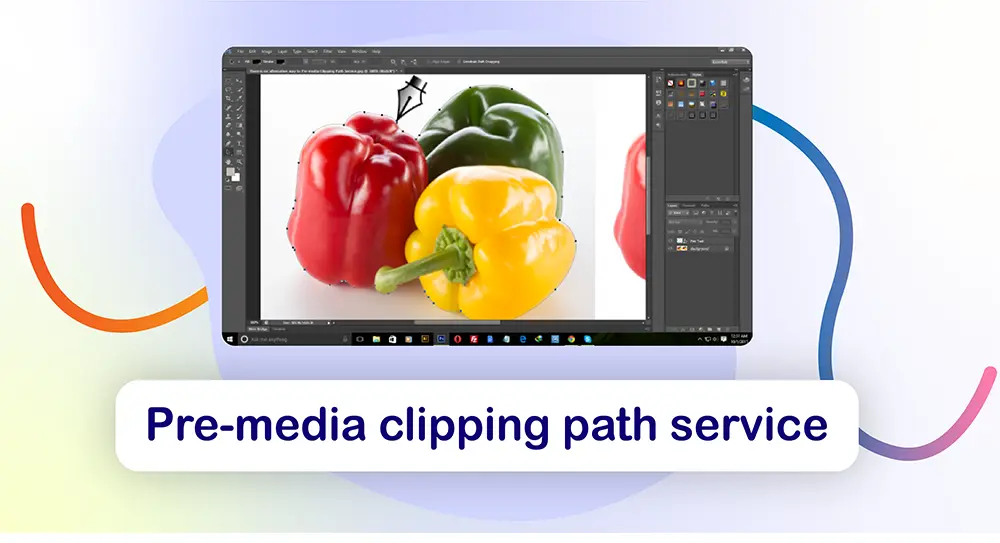
pre-media clipping path service is a fundamental technique in the realm of graphic design and image editing, carrying significant importance across various industries, particularly in marketing, e-commerce, advertising, and publishing.
At its core, a clipping path involves precisely outlining or cutting out a specific portion of an image using graphic software, with Adobe Photoshop being a prominent tool for this purpose. This technique allows for the isolation of a desired object from its background by creating a path or vector-based outline around it. The primary objective is to detach the object, ensuring it can be placed on a different background or integrated seamlessly into various design layouts.
Importance of Pre-media Clipping Path Services:
let’s delve deeper into the importance and impact of pre-media clipping path services across various sectors.
Visual Enhancement and Aesthetics:
Clipping path services are pivotal in enhancing the visual appeal of images by meticulously removing distracting or undesired backgrounds. In e-commerce, for instance, clean and isolated product images significantly influence purchasing decisions. When a product stands alone against a neutral or custom background, customers can focus on its details, increasing the likelihood of making a purchase.
Moreover, in advertising and marketing, captivating visuals are key to capturing the audience’s attention. A well-executed clipping path ensures that the intended subject remains the focal point, conveying the message clearly and effectively. Whether it’s an advertisement for a product or a marketing campaign, the visual impact is heightened when the focus is sharp and distractions are eliminated.
Flexibility and Adaptability in Design:
The ability to detach objects from their backgrounds grants designers immense creative flexibility. With this technique, designers can experiment with various backgrounds or settings, tailoring images to specific contexts or marketing requirements. This adaptability ensures that images seamlessly fit into different layouts or campaigns, enhancing the overall aesthetic appeal and communicative power of designs.
Precision and Detailing:
The hallmark of clipping path services lies in their precision and attention to detail. Skilled professionals use software tools to intricately trace the edges of objects, ensuring a seamless, natural appearance after isolation. This level of precision becomes crucial when dealing with intricate or finely detailed subjects, such as jewelry, textiles with complex patterns, or objects with irregular shapes. Maintaining the integrity of these details contributes significantly to the overall quality of the final image.
Branding and Marketing Impact:
Consistency in visual representation is paramount in branding and marketing strategies. Clipping path services play a crucial role in ensuring that product images or promotional materials reflect professionalism and visual coherence. When consumers encounter consistent and high-quality visuals across various marketing channels, it strengthens brand recognition and fosters trust. The ability to present products or messages in a visually appealing and consistent manner greatly influences consumer perception.
Streamlining Production Workflow:
For businesses dealing with a high volume of images, outsourcing clipping path services streamlines the production process. By entrusting this task to specialized service providers or employing automated processes, professionals can allocate their time and resources more efficiently. This streamlined workflow allows them to focus on other critical aspects of design, content creation, or marketing strategies, ultimately improving productivity and output quality.
Levels of Clipping Path Complexity:
Clipping path services are categorized into different levels of complexity based on the intricacy of the objects being outlined. These levels determine the effort, time, and skill required to achieve precise and clean cutouts.
Levels of Clipping Path Complexity:
- Basic Clipping Path:
- Description: Basic clipping paths are used for objects with simple and well-defined shapes that have straight edges.
- Examples: Products like mobile phones, books, or simple geometric shapes fall under this category.
- Complexity: Minimal effort and time are required as these objects have clear and distinct boundaries, making the outlining process relatively straightforward.
- Medium Clipping Path:
- Description: Medium clipping paths involve objects with moderate complexity, including curved edges or multiple contours.
- Examples: Items like a group of shoes, a simple piece of jewelry, or objects with some intricate edges.
- Complexity: These paths require more precision and attention to detail compared to basic paths due to the presence of curves or multiple edges. However, they are not as intricate as highly complex objects.
- Complex Clipping Path:
- Description: Complex clipping paths deal with highly intricate objects that have numerous edges, fine details, or irregular shapes.
- Examples: Intricate jewelry pieces, fabric with intricate patterns, or objects with irregular outlines belong to this category.
- Complexity: Achieving accuracy in complex clipping paths demands advanced skills and expertise. These paths involve intricate details, multiple edges, or irregular shapes, requiring a significant amount of time and attention to ensure a seamless and natural appearance after isolation.
Importance of Understanding Levels of Complexity:
Understanding the levels of clipping path complexity is crucial for both service providers and clients. It helps in:
- Resource Allocation: Service providers can allocate appropriate resources, time, and expertise based on the complexity level, ensuring efficient and high-quality outcomes.
- Client Expectations: Clients can communicate their requirements more accurately by specifying the complexity level required for their images. This helps in setting realistic expectations regarding the detailing and effort involved in the clipping path process.
- Cost Estimation: Different complexity levels entail varying degrees of effort and time. Clients can receive accurate cost estimates based on the complexity of their images, allowing for fair pricing and budget planning.
In summary, the categorization of clipping path complexities into basic, medium, and complex levels assists both service providers and clients in effectively managing expectations, resources, and outcomes in image editing and design projects.
Suggested article >>




Thanks for your idea is different from everyone else, it’s a lot for my benefit
Incredible post, really I have enjoyed the post a lot. Thanks.